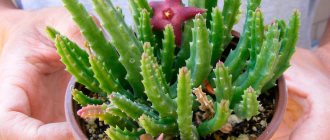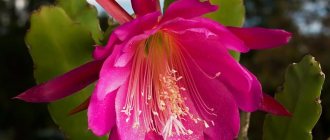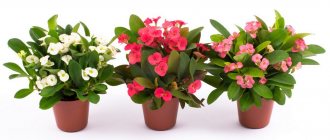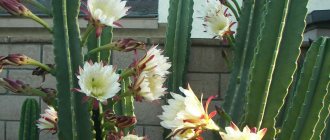The spurge cactus plant is a succulent with a triangular stem and small leaves. In its natural habitat it grows in harsh conditions, so at home it retains its decorative appearance for a long time even without proper care. To grow a succulent you need to have some experience and knowledge.
Euphorbia cactus - description
The place of origin of the plant is the island of Madagascar and the subtropics of Africa. In nature, there are more than 2 thousand species of monoecious and dioecious succulents. Under natural conditions, indoor spurge cactus reaches a height of 6-8 m. The plant has a fleshy trunk with a ribbed surface, which is all studded with small spines. Another name for the succulent is Mexican cactus.
Indoors, the plant can stretch 2-3 m, and its bright green stems begin to branch greatly. Small oblong leaves reach 2-3 cm in length. They are located at the top of the milkweed cactus. The leaves quickly fall off, but new ones grow in their place. You can often find the plant in office premises, on balconies or covered terraces.
How does the spurge cactus bloom?
Keeping a succulent at home requires some knowledge about its characteristics. For example, the plant grows quickly and reaches up to 3 m in length, forming a large number of side shoots. The bright green stems and oblong leaves have a decorative appearance. Euphorbia euphorbia cactus, under the right conditions, pleases owners for several years. When grown indoors, the succulent does not bloom, but in its natural subtropical environment it forms small white buds.
Is spurge cactus poisonous or not?
Amateur gardeners are hesitant to plant a succulent because they are afraid of its characteristics. It is believed that the spurge plant negatively affects the human nervous system and causes insomnia. In addition, the presence of milky sap with toxic properties becomes an unpleasant phenomenon for gardeners. When it gets on the surface of the skin, blisters, redness, and severe itching occur. The affected areas of the body should be immediately washed and lubricated with glucocorticoid cream. If milkweed juice is ingested, vomiting and diarrhea immediately occur. If it penetrates the eyes, it causes blindness.
However, the plant also has beneficial properties, for example, it is able to purify indoor air and destroy dangerous microorganisms. Indoor spurge cactus is used to remove warts, calluses or corns. In India, the stems are dried, crushed, and the powder is sprinkled on wounds from snake bites. When collecting poisonous sap, it is important to prevent its inhalation and contact with the surface of the skin or mucous membranes.
Advice from an expert: how to form a bush from triangular milkweed
We did a little research and found out the most common problem when growing triangular milkweed. Most beginners have no idea how to correctly form the trunk of a succulent and achieve the appearance of side shoots. Florist Tatyana Kilmyashkina talks about how to achieve the desired result and not harm your pet.
With the arrival of autumn, it is very important to pay attention to your house plants, to see if any specimen needs the formation of a trunk. Regarding milkweed, this procedure can be carried out in the spring, but during the period of increased growth the plant experiences increased stress. While pruning before winter will take place without any noticeable losses, because very soon the succulent will fall asleep and have time to fully recover before the growing season begins. What is important is that during the winter the necessary offshoots will form on the cut. And in the spring there will be something to grow.
Types of milkweed cactus
The decorative succulent is common as a house flower in many countries. In addition, the spurge cactus can be found in forests and wild meadows. It perfectly tolerates a lack of moisture, accumulating it inside the trunks. Popular species that have attracted amateur gardeners to grow at home include:
- Euphorbia Canarian cactus
, reaching up to 12 m in height. Its stems are ribbed with small tubercles, under which the base of an oblong leaf begins. - The most popular spurge cactus is triangular
, with slightly flattened trunks. A distinctive feature of the plant is the double type of spine. - Euphorbia tirucalli cactus
, which looks like a real tree, reaching a height of 8-10 m. The branches of the plant are thick, bright green, completely without thorns. The leaves of this species have a linear shape.
Euphorbia cactus - home care
This succulent is called a real gift for those who are just starting out in floriculture. The homemade Euphorbia triangular cactus can survive in different conditions and tolerates long breaks in care. It can easily withstand a lack of sunlight, location near heating radiators and infrequent watering. However, if a euphorbia flower is kept in conditions that are comfortable for it, then it will develop much better. The main stages of care include:
- regular watering with settled water;
- proper feeding of succulents;
- periodic replanting into a container with loose soil;
- timely pruning of the plant;
- mandatory prevention of dangerous diseases.
For proper growth and development, the spurge cactus needs a breathable substrate, which can be purchased in specialized stores. In addition, the mixture is prepared independently by mixing river sand and peat in equal proportions. Fertilize home flowers only from spring to autumn. Special compositions for cacti are used once every 2-3 weeks strictly according to the instructions.
How to prune a spurge cactus?
Some gardeners do not want to limit the growth of the plant, so it reaches large sizes and becomes the main decoration of the interior. However, if the owner does not want his beloved home spurge cactus to reach an unimaginable height or the room parameters do not contribute to this, then the best way is to prune it in a timely manner. It helps to form a strong bush of bright green thick stems.
If a gardener doubts his skills, then you can use an interesting way to stop the growth of a milkweed cactus. A bottle cap is placed on the top of the succulent, which prevents further growth and ensures the active development of side shoots. The technology for pruning succulents is simple:
- The top of the trunk is shortened to the desired level with a sharp knife or pruning shears.
- The remaining sections are sprinkled with charcoal crushed to powder to speed up the overgrowth of the stem.
How to replant a spurge cactus?
For better growth and development of the succulent, it is important to regularly change the size of the container in which the succulent grows. So, a young domestic euphorbia flower is transplanted into a pot of larger diameter annually, and adult specimens – once every 3 years. Experts recommend replacing the top layer of soil in the container with fresh substrate every spring. For replanting, take a new pot with a larger diameter than the old one. The container itself should be stable, wide, and of medium depth.
The root system of the milkweed cactus is located on the surface, so the plant can fall. To prevent this from happening, each time after replanting, an adult succulent is strengthened with decorative stones. They are laid out around the flower at the bottom of the pot. The transplantation process is not complicated and consists of the following stages:
- release the plant from the old container;
- inspect the roots and remove dead areas;
- pour drainage onto the bottom of the pot;
- fill one third of it with loose substrate;
- place milkweed;
- cover with soil, straightening the roots;
- pour water at room temperature;
- compact the top layer of soil.
Euphorbia cactus - reproduction
Spring is considered the most favorable time for any action with the plant. Domestic triangular spurge is propagated in different ways:
- By cuttings
. The length of the lateral layers must be at least 10 cm. They are rooted in a moist substrate until roots appear. - Seeds
. This is how hybrids are propagated in laboratory conditions. For a home, this method is considered too labor-intensive. - Bush division
. In spring, the stem is cut into separate parts. An important condition is the presence of a root on each of them. After dividing, they are planted in separate containers with moist, loose soil.
Purchase and step-by-step transplantation steps
After purchasing milkweed, the flower must be carefully checked for pests. Next, rinse the plant under running warm water. After this, the flower must adapt to environmental conditions in isolation from other plants. The adaptation period takes 1-2 weeks.
Now, finally, you can transplant the triangular spurge to a permanent location. The container should be equipped according to the above instructions. Replanting must be done carefully, trying to clean the roots as much as possible from the old soil without damaging them.
Diseases of the milkweed flower
A strong plant is rarely attacked by pests. This is explained by the fact that juice with poisonous properties is an excellent remedy in the fight against them. However, the euphorbia cactus can be disturbed by some pests:
- aphids;
- red spider mite;
- mealybug.
A home flower does not require complex care, but its absence leads to:
- shedding of leaves from excessive watering;
- yellowing due to a large amount of fertilizer or lack thereof;
- the appearance of brown spots when exposed to direct sunlight.
Euphorbia cactus in the interior
The home flower euphorbia has an unusual and very decorative appearance. Not everyone is scared off by its poisonous juice; the spurge cactus can also bring benefits to the owner of a house or apartment. The succulent purifies the air in the room and kills harmful microorganisms. The cactus plant is a tall spurge, so it is best to keep it in non-residential areas. Succulents can often be found in offices. Simple care of euphorbia also affects the popularity of the flower.
You should not place it in the bedroom, because the subtle aroma of the plant leads to sleep disturbances and insomnia. The succulent looks good in arrangements with other potted flowers that have the same stem color as milkweed. It goes well with scarlet and Kalanchoe. Decorative pots emphasize the ascetic beauty of the plant, making it a real decoration of the room.
Options for using milkweed in the interior:
- Large specimens can be installed in any room alone or in groups.
- Cacti are appropriate both for floor placement and on tables, cabinets, and stands.
- Bright green spurge looks organic on both dark and light backgrounds.
Bush dividing method
To propagate this plant, you can use the method of dividing its roots.
Advantages and disadvantages of the method
This method takes a minimum amount of time, and the plant is healthier. However, there is a possibility that the new plant will have the same diseases as its parent. There is also a risk that new ground shoots will never appear.
How to choose and prepare a bush?
First you need to choose a parent plant. It is taken out of the pot. Remove the entire top part. Rinse the roots with water that has undergone a filtration process. The parts into which the roots are divided must contain a bud or sprout.
Coal or wood ash is used to dry the cut.
How to root?
Procedure:
- They take a special remedy. They process the parts with it.
- Prepare the pot. Fill it with drainage and soil.
- Moisten the soil.
- The seedling is planted.
- The soil should be pressed down without touching the new plant.











